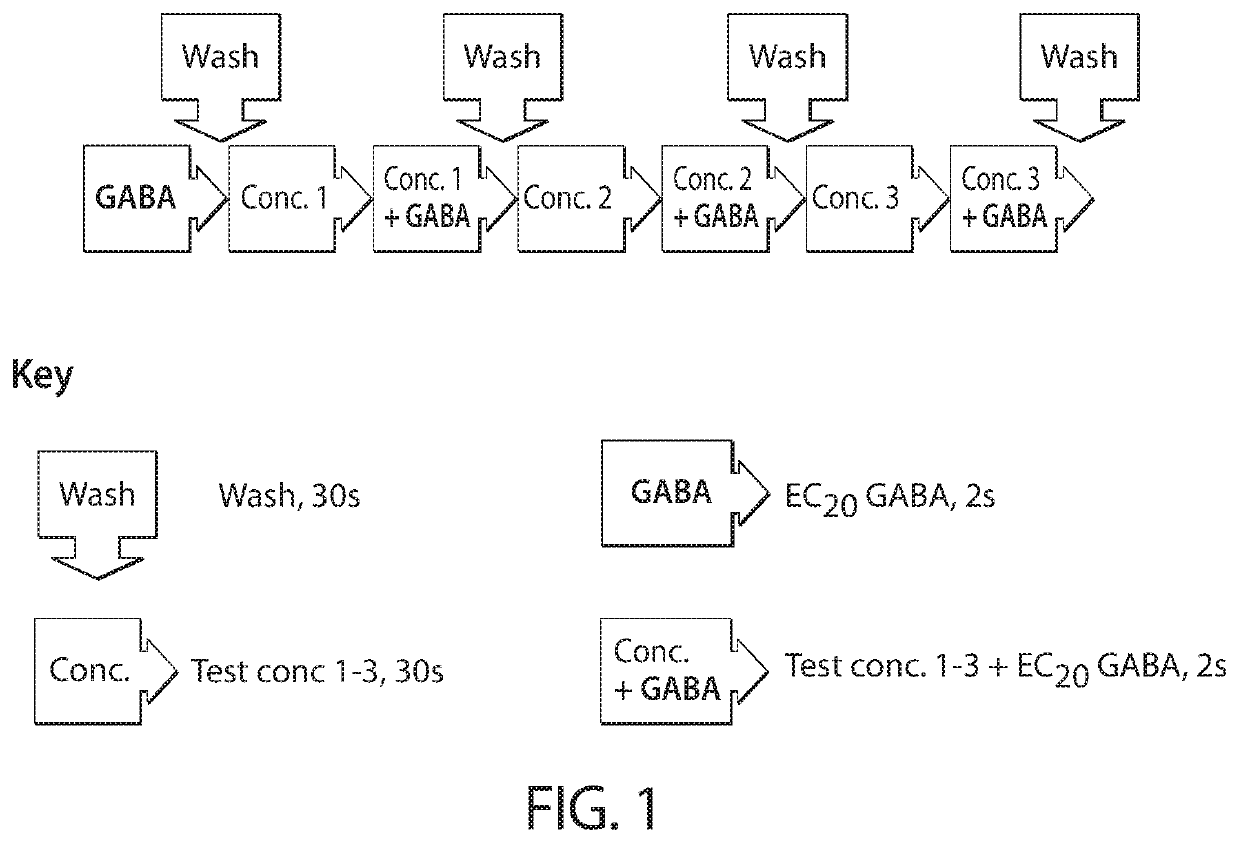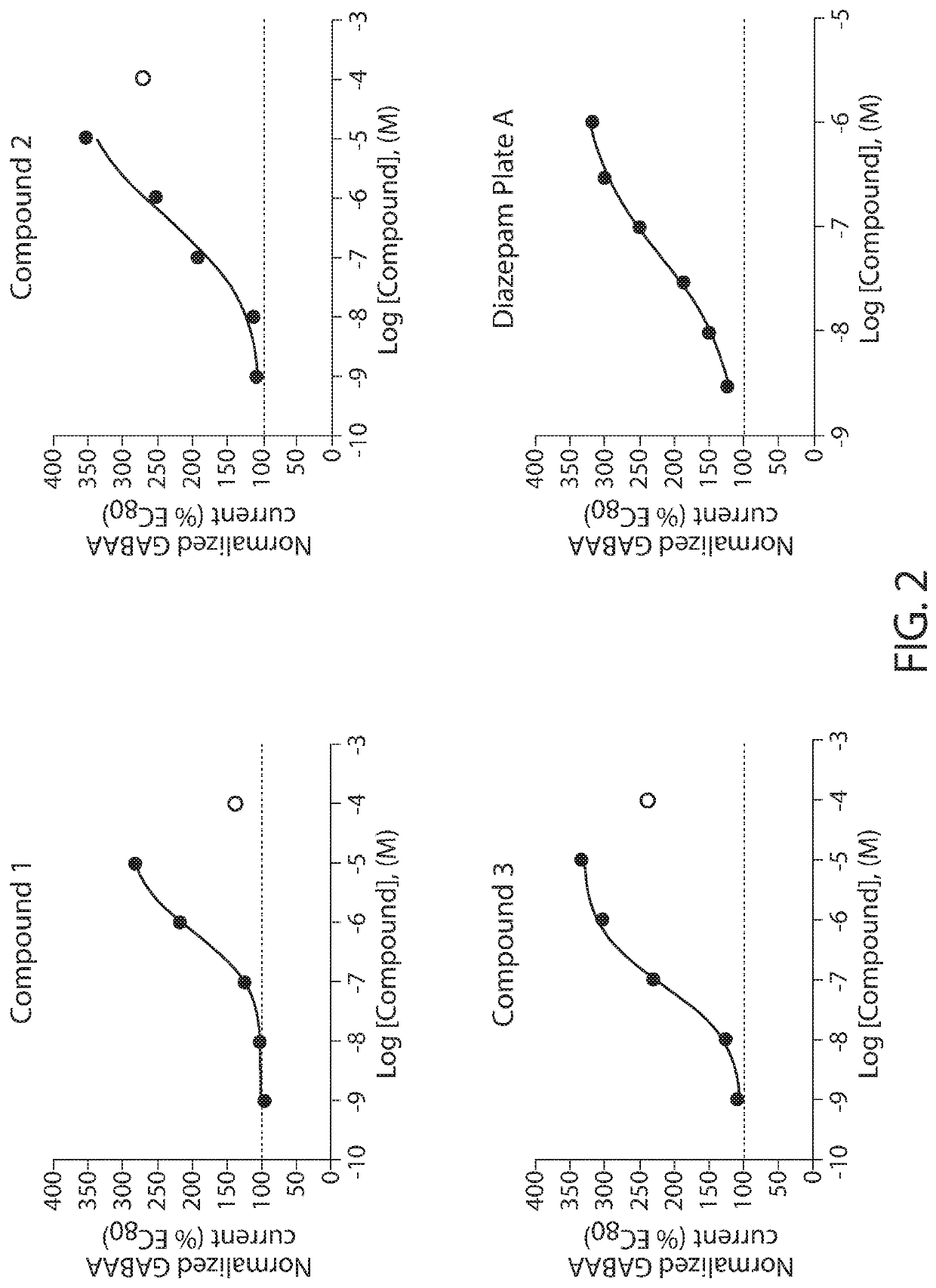Compositions and methods for reducing tactile dysfunction, anxiety, and social impairment
a technology of social impairment and anxiety, applied in the field of compositions and methods for reducing social impairment, anxiety, and tactile dysfunction, can solve the problem of no fda-approved treatmen
- Summary
- Abstract
- Description
- Claims
- Application Information
AI Technical Summary
Benefits of technology
Problems solved by technology
Method used
Image
Examples
example 1
and Methods
[0280]The compounds described herein are synthesized according to the following methods. All starting materials in the synthetic schemes are prepared according to procedures known to one of skill in the art.
[0281]
[0282]
[0283]
[0284]
[0285]
example 2
of Compounds 36, 37, 38, and 39
[0286]
[0287]
General Procedure for Preparation of Intermediate 2
[0288]
[0289]A mixture of compound 1 (20 g, 155 mmol, 1.00 eq) 4-chlorobenzaldehyde (26.2 g, 186 mmol, 1.20 eq) in toluene (200 mL) was degassed and purged with N2 for 3 times, and then the mixture was stirred at 120° C. for 15 h under N2 atmosphere. The resulting mixture containing imine was cooled down to 25° C. and ethyl prop-2-ynoate (30.5 g, 311 mmol, 30.5 mL, 2.00 eq), Cu(OAc)2 (18.1 g, 0.1 mol, 6.43e—1 eq) and H2O (2 mL) was added. The reaction mixture was stirred additionally at 120° C. for 4 h under 02 atmosphere. TLC (plate 1) (Petroleum ether:Ethyl acetate=1:1, Rf=0.72) indicated ˜5% of Reactant 1 was remained, and one major new spot with lower polarity was detected. TLC (plate 2) (Petroleum ether:Ethyl acetate=4:1, Rf=0.03) indicated intermediate was consumed completely and many new spots formed. TLC (plate 3) (Petroleum ether:Ethyl acetate=1:1, Rf=0.56) indicated one major new s...
example 3
of Compounds 34 and 35
[0350]
[0351]
General Procedure for Preparation of Compound 5-2
[0352]
[0353]To a solution of compound 5-1 (500 mg, 1.90 mmol, 1.00 eq) and TEA (385 mg, 3.81 mmol, 530 uL, 2.00 eq) in DCM (5.00 mL) was added dropwise phenyl carbonochloridate (328 mg, 2.09 mmol, 262 uL, 1.10 eq) in DCM (2.00 mL) at 0-5° C. The reaction temperature was gradually raised to 20° C. and stirred for 3 h. TLC (Petroleum ether / Ethyl acetate=2 / 1, Rf=0.59) indicated compound 5-1 was consumed completely and one new spot formed. The reaction mixture was diluted with H2O (10 mL) and extracted with DCM (20 mL). The combined organic layers were washed with brine (5 mL), dried over Na2SO4, filtered and concentrated under reduced pressure to give a residue. Compound 5-2 (800 mg, crude) was obtained as a white solid, which was used into next step directly without purification further.
[0354]1H NMR: ET25243-7-P1A 400 MHz DMSO-d6
General Procedure for Preparation of Compound 5-3
[0355]
[0356]To a solution...
PUM
| Property | Measurement | Unit |
|---|---|---|
| mole fraction | aaaaa | aaaaa |
| mole fraction | aaaaa | aaaaa |
| mole fraction | aaaaa | aaaaa |
Abstract
Description
Claims
Application Information
 Login to View More
Login to View More - R&D
- Intellectual Property
- Life Sciences
- Materials
- Tech Scout
- Unparalleled Data Quality
- Higher Quality Content
- 60% Fewer Hallucinations
Browse by: Latest US Patents, China's latest patents, Technical Efficacy Thesaurus, Application Domain, Technology Topic, Popular Technical Reports.
© 2025 PatSnap. All rights reserved.Legal|Privacy policy|Modern Slavery Act Transparency Statement|Sitemap|About US| Contact US: help@patsnap.com



